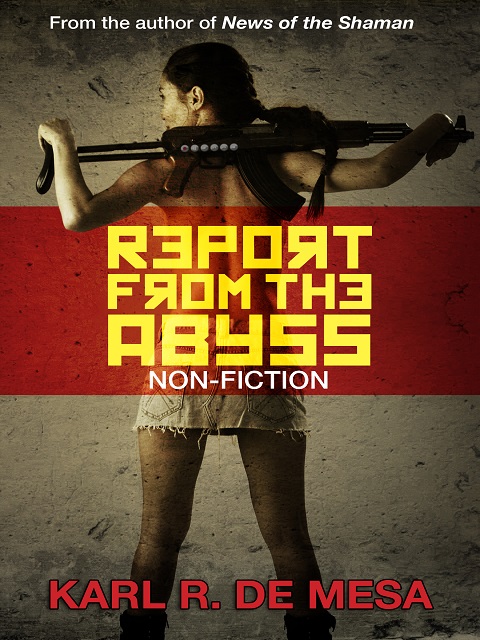Filtered By: Lifestyle
Lifestyle
Book review: Refracting darkness in 'Report from the Abyss'
By VIDA CRUZ, GMA News

The print edition's cover. Photos courtesy of Karl R. De Mesa
What is unique about “Report from the Abyss” is that De Mesa—who is a regular contributor to, and part-time editor for, GMA News Online—manages to use refraction, a property of light, in order to talk about darkness.
Composed of autobiographical essays, a defense of horror, travelogues, and reportage on local superstitions and institutions, the collection is able to refract two things: the feeling of horror, and the "abyss" itself, often at the same time. This is most evident with two of the three essays in "Part One: Open Your Hands and Step Into the Void, Child," the first part of five sections that divide the slim volume.
“Report from the Abyss: Episodes from a coming of age in the Philippine Left,” the essay from which the collection takes its name, delivers exactly what its title promises. Readers are treated to detailed narrations of being inside a bus as a child while rallyists throw sharp projectiles at the windows; to caring for a broken father incarcerated during Martial Law; to watching his parents' marriage crumble, eroded by the Cause—these among a slew of other turbulent scenes.
“My Transcendental Knife: A manifesto for horror stories as psychic self-defense,” meanwhile, is an articulation of his personal poetics as a writer. Readers find out here that for the author, the writing of horror fiction is a therapeutic experience, a kind of exorcising of demons by going to the source—the "primal state of the human condition"—deep inside his own psyche and discovering what terrifies him; and in so doing, what terrifies everyone everywhere.
What the two essays at the beginning do best is refract horror, the dark side of the soul and of human nature, and elicit from your gut horror's many shades: disgust, anxiety, suspense, loathing, terror, and everything else in between.
These lay the groundwork for the rest of the book, which truly is a "report" of sorts. From a microscopic focus into what's within him, the reader is moved to an examination of the author's more public persona and where it's gotten him—between jobs, in Shariff Aguak in 2009, terribly ill, or else working for a small cable TV channel ("Part Two: How I Learned to Trust My Black Shirt"); shifting to an examination of the endearing quirks and superstitions of society ("Part Three: Friends in Bat Country – Fringe Arcana"); then, surprisingly, digging up a wealth of scientifically unverifiable (but strangely satisfying) information on supposed unknowns such as angels, UFOs, and ghosts ("Part Four: Down the Up Staircase"); and finally, to "Part Five: Ripped from a Glossy," which kind of pulls the reader back down to earth with its glimpse into the daily goings-on inside eco-law enforcement, a day in the life of Bilibid prisoners, and the impact of dwindling numbers of recruits into the priesthood.

The digital edition's cover.
But I like reading my books from cover to cover, and I noticed that with this one in particular, the subject matter becomes increasingly more mysterious and my own range of emotions became increasingly complex. Yet why were essays shedding light on certain very human institutions—surely less enigmatic than succubi or angels—positioned at the end of the book?
I'd like to believe that this is commentary on human nature itself and the extremes to which it can lean, whether this is the dark matter that can keep you locked away in a dim cell for a long time or the soaring heights that could push you to submit yourself to a seminary (or a nunnery). Neither of these institutions are all that transparent.
Anything can happen beyond the walls of space, time, and the human mind, but behind such walls, the simultaneous predictability and unpredictability of human nature, this strange mix of the known and the unknown—though we have lived with this ever since—still continues to shock. To amaze. To terrify.
The abyss yawns widest and deepest at the edge of collective human nature and all its refracted shades and hues between light and dark. And with “Report from the Abyss” acting successfully as a prism for all these complicated emotions, this is how you know that De Mesa knows what he's writing about.
"Report from the Abyss" is available at any National Book Store branch. It's digital edition is published by Flipside Digital Content Inc. and it can be purchased on Flipreads, Amazon, Kobo, and iTunes. — BM, GMA News
Tags: bookreview, nonfiction
More Videos
Most Popular



